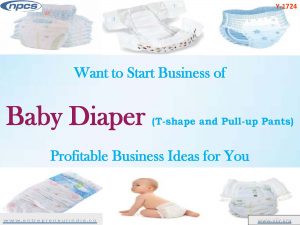Emerging Investment Opportunities in Production Business of Baby Diaper (T-shape and Pull-up Pants)

Introduction:
In today’s world, baby diapers are a great comfort. A baby diaper is a more sophisticated version of a nappy made of cotton and absorbent material that absorbs the waste material of the baby without making him feel wet after passing discharges. It keeps the baby’s delicate skin dry and moisturized. It often lessens the incidence of rashes on the baby’s face. Parents all over the world use baby diapers safely every day. Plastic outer skirts, ill-fitting terry cloth inners, and chronically wet skin for babies and infants are long gone. Disposable diapers are light, lightweight, absorbent, leak-proof, and simple to use today. The softness, lightness, and ‘breathability’ of the fabrics used in baby diapers make them very easy to wear.
Related Project: – DISPOSABLE BABY DIAPER
Benefits of Using Baby Diaper:
The primary goal of using a Baby diaper is to contain the moisture from the baby’s faeces so that the baby does not get fussy or wake up due to the dampness. When a baby may engage in long-term activities while remaining flexible and relaxed, as well as sleep through the night, it benefits their growth and long-term physical and mental health. When your baby starts wriggling or rolling over during diaper changes to get away from you, any change can become a war of wills (which the smaller, cuter and chubbier one usually wins). Tape diapers easily become a setback until your baby is ready for potty training because they need your involvement to put on and take off. Tape diapers can sag or flip open on one side as a result of an older baby’s vigorous playtime routine. Parents should change the tape under the baby’s navel as needed for newborns whose umbilical cords have not yet fallen off.
Books: – BOOKS & DATABASES
Diapers for newborns now feature a soft touch surface that is gentle on the baby’s delicate skin, as well as a unique curved waistband shape. The baby’s navel region is well shielded from friction, so parents can rest easy.
Manufacturing Process:
An absorbent pad is sandwiched between two sheets of nonwoven fabric in a baby diaper. The nonwoven fabric gives the diaper a comfortable shape and helps avoid leakage. The absorbent pad is vacuum-formed first, then attached to a permeable top sheet and impermeable bottom sheet in a multi-step process. Heat or ultrasonic vibrations are used to seal the components together. Elastic fibres are added to the sheets to gather the diaper’s edges into the correct form, ensuring that it fits snugly around the legs and crotch of an infant. The disposable diaper can hold body fluids that move through the permeable top sheet and are absorbed into the pad when properly equipped.
Related Videos: – Sanitary Napkins, Baby and Adult Diapers, Feminine Hygiene Products, Sanitary Pads, Sanitary Towel, Menstrual Pad, Maxi Pad
The majority of the methods used to monitor the consistency of Baby diapers are related to the absorbency of the product. One important factor to consider is the polymer/fiber ratio in the absorbent pad. The diaper’s ability to absorb moisture would be harmed if there is too much variation. To integrate absorbent polymers into the pad, at least two methods have been used. One approach involves injecting the polymer into the same feedstock that supplies the fibres. This method produces a pad with an even distribution of absorbent polymer over its length, width, and thickness.
Marketing Outlook
The global baby diapers market was estimated at $52.6 billion in 2019 and is expected to grow at a CAGR of 5.0 percent to $68.3 billion by 2027. With shifting consumer tastes, the baby diaper market has become increasingly complex. Diaper fabric, absorption capabilities, and unique user-friendly features have all improved in recent years, allowing rivals to gain market share. Manufacturers are being forced to produce bio-based disposable diapers in response to the demand for natural and hygienic goods, which is expected to drive consumer demand.
Market Research: – Market Research Report
The region’s dominance in the global diaper industry can be attributed to the region’s growing population, which is due to high birth and fertility rates as well as longer life expectancy, as well as the rising number of adult incontinence patients. Other factors driving up diaper demand in the area include increased knowledge of baby hygiene and less reservations about using adult diapers. Disposable Baby diapers are likely to be favored by parents over other forms of diapers such as cloth, training nappy, and others due to their ease of use and comfort. Companies are concentrating on disposable diaper recycling as well as designing disposable diapers. Leading businesses are designing plants that recycle disposable diapers as part of a variety of initiatives. Hypermarkets/supermarkets, convenience stores, pharmacies/drug stores, online distribution channels, and others make up the baby diaper sector.
Key Players:
- Centron Industrial Alliance Ltd.
- Diapers India Ltd.
- Godrej Hygiene Products Ltd.
- Johnson & Johnson Pvt. Ltd.
- Kimberly-Clark India Pvt. Ltd.
- Maple Biotech Pvt. Ltd.
- Me N Moms Pvt. Ltd.
- Nobel Hygiene Pvt. Ltd.
- Procter & Gamble Home Products Pvt. Ltd.
- S C A Hygiene Products India Pvt. Ltd.
- Tainwala Personal Care Products Pvt. Ltd.
- Unicharm India Pvt. Ltd.
- Vandana Surgi Pharma Pvt. Ltd.
For More Details: – https://www.entrepreneurindia.co/project-and-profile-listing.aspx?srch=Baby%20Diaper
